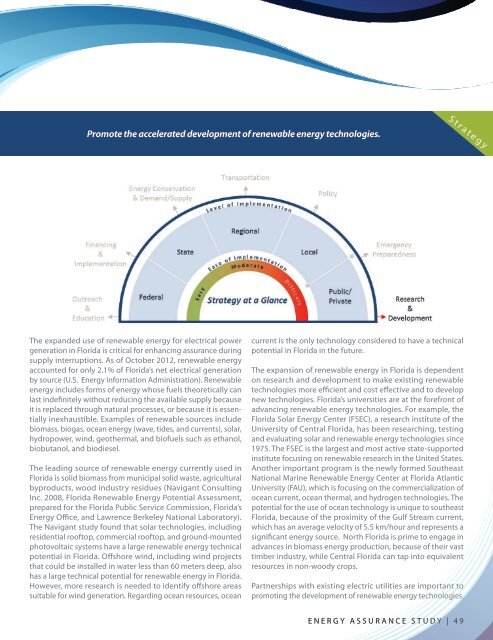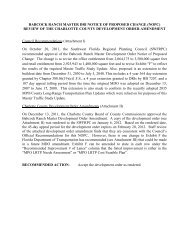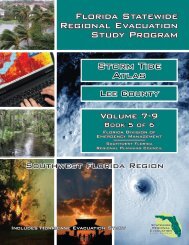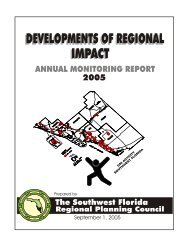Energy Assurance Study: Interim Report - Southwest Florida ...
Energy Assurance Study: Interim Report - Southwest Florida ...
Energy Assurance Study: Interim Report - Southwest Florida ...
- No tags were found...
You also want an ePaper? Increase the reach of your titles
YUMPU automatically turns print PDFs into web optimized ePapers that Google loves.
Promote the accelerated development of renewable energy technologies.StrategyThe expanded use of renewable energy for electrical powergeneration in <strong>Florida</strong> is critical for enhancing assurance duringsupply interruptions. As of October 2012, renewable energyaccounted for only 2.1% of <strong>Florida</strong>’s net electrical generationby source (U.S. <strong>Energy</strong> Information Administration). Renewableenergy includes forms of energy whose fuels theoretically canlast indefinitely without reducing the available supply becauseit is replaced through natural processes, or because it is essentiallyinexhaustible. Examples of renewable sources includebiomass, biogas, ocean energy (wave, tides, and currents), solar,hydropower, wind, geothermal, and biofuels such as ethanol,biobutanol, and biodiesel.The leading source of renewable energy currently used in<strong>Florida</strong> is solid biomass from municipal solid waste, agriculturalbyproducts, wood industry residues (Navigant ConsultingInc. 2008, <strong>Florida</strong> Renewable <strong>Energy</strong> Potential Assessment,prepared for the <strong>Florida</strong> Public Service Commission, <strong>Florida</strong>’s<strong>Energy</strong> Office, and Lawrence Berkeley National Laboratory).The Navigant study found that solar technologies, includingresidential rooftop, commercial rooftop, and ground-mountedphotovoltaic systems have a large renewable energy technicalpotential in <strong>Florida</strong>. Offshore wind, including wind projectsthat could be installed in water less than 60 meters deep, alsohas a large technical potential for renewable energy in <strong>Florida</strong>.However, more research is needed to identify offshore areassuitable for wind generation. Regarding ocean resources, oceancurrent is the only technology considered to have a technicalpotential in <strong>Florida</strong> in the future.The expansion of renewable energy in <strong>Florida</strong> is dependenton research and development to make existing renewabletechnologies more efficient and cost effective and to developnew technologies. <strong>Florida</strong>’s universities are at the forefront ofadvancing renewable energy technologies. For example, the<strong>Florida</strong> Solar <strong>Energy</strong> Center (FSEC), a research institute of theUniversity of Central <strong>Florida</strong>, has been researching, testingand evaluating solar and renewable energy technologies since1975. The FSEC is the largest and most active state-supportedinstitute focusing on renewable research in the United States.Another important program is the newly formed SoutheastNational Marine Renewable <strong>Energy</strong> Center at <strong>Florida</strong> AtlanticUniversity (FAU), which is focusing on the commercialization ofocean current, ocean thermal, and hydrogen technologies. Thepotential for the use of ocean technology is unique to southeast<strong>Florida</strong>, because of the proximity of the Gulf Stream current,which has an average velocity of 5.5 km/hour and represents asignificant energy source. North <strong>Florida</strong> is prime to engage inadvances in biomass energy production, because of their vasttimber industry, while Central <strong>Florida</strong> can tap into equivalentresources in non-woody crops.Partnerships with existing electric utilities are important topromoting the development of renewable energy technologies.ENERGY ASSURANCE STUDY | 49









